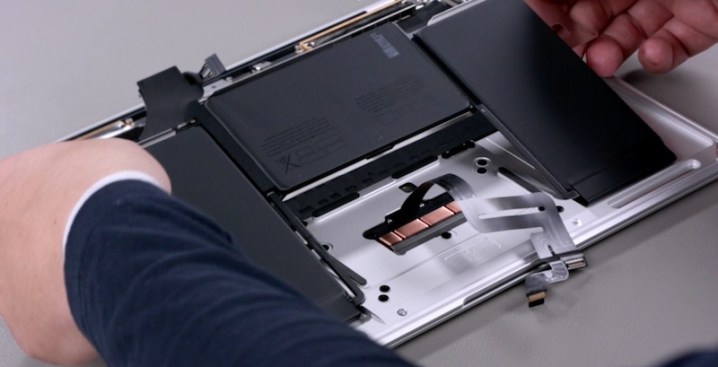
To go along with the environmentally friendly theme of the new MacBook Air for 2018, Apple is making the battery easier to replace inside its latest laptop, though home users still may not be able to service the battery themselves. The process isn’t quite as simple as popping open the MacBook Air’s casing and swapping out a depleted battery for a new one, but in redesigning the notebook, Apple is giving service technicians the necessary tools to replace just the battery, rather than the whole top case.
Like Apple’s current crop of notebooks, including the MacBook and the MacBook Pro, the MacBook Air’s battery is still affixed inside via glue. However, according to Apple’s service documents sent to its service providers and glimpsed by MacRumors, Apple, authorized service centers will now be given the tools to remove the battery and reinstall a new one should servicing be needed. “Once the new battery is installed, technicians are required to place the notebook in Apple’s existing iPhone display press tool to activate the new adhesive,” the publication reported. “The glue strips are exactly the same as those used for iPhone batteries.”
In the past, replacing internal components that required service technicians to also replace the top case contributed to increasing repair costs. A widely documented example of is the repair costs associated with Apple’s first- and second-generation butterfly switch keyboards. Because replacing the keyboard required replacing the top cover as well, keyboard repairs were reported to be twice as much as keyboard repairs on older Apple notebooks.
By allowing technicians to save the top case and just replace the battery, Apple is essentially reducing the cost and waste associated with repairs related to battery issues. Apple made a big deal about the MacBook Air’s design and environmental impact when it introduced the laptop in late October, with executives highlighting that the laptop is Apple’s first Mac made from 100 percent recycled aluminum. In addition to aluminum, Apple also claimed that the Air is made from 60 percent recycled plastic.
Though the process for replacing the battery is more complex than the older generations of MacBook Air, Apple may have had to rely on adhesives to keep the design of the laptop slim. On older models, the battery was secured by screws, which are accessible once the laptop was opened.
In addition to making battery repairs simpler for technicians and Apple’s own Genius Bar staff, the service guide also points out that the new larger trackpad and Touch ID sensor can also be individually replaced. On the MacBook Air, if the Touch ID fingerprint scanner fails, replacing the sensor no longer requires a full replacement of the logic board. However, Apple states that the laptop has to pass a diagnostics test for the repair to be completed.


